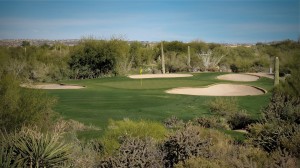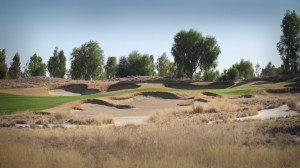
Easy on the eye after hacking through cactus, scrub and small targets, Encanterra still challenges; the short 12th hole is about the most fun par four on the course.
During nearly a dozen trips to Arizona, there have been times when the desert golf courses blend into mnemonic mush, thanks to strings of remarkably similar holes. Typical is one that begins with a Saguaro about 30 yards ahead of the tee, riddled with ball-sized holes like some victim of a gangland hit. A couple hundred yards out a rock outcropping bifurcates the landing zone. And while the fairway is carpeted by lush grass, it’s flanked by an alternate universe of nasty cactus, sand and dense scrub – – rough straight out of hell.
The Sonoran Desert is also home to courses both heavenly and spectacular. Indeed, the earth simply doesn’t produce rocks much bigger than the boulders at The Boulders. And at the 236-yard par three fifth hole of the Gold Canyon Dinosaur Mountain course, a tee shot hangs against the backdrop of the Superstition Mountains before reaching full velocity on a 181-foot vertical drop from tee to green. Deserts clearly present architects with a surfeit of creative options.
During the ninth annual Xona Resort Suites Scottsdale Media Golf Classic last December, my pal Wayne Freedman and I played five different courses. Remarkably, none had a great deal in common with the others. In fact, each presented a distinct interpretation of golf in the desert. Wayne’s accompanying photos – – and his own thoughts about the courses at his KGO Channel 7 website – – well illustrate the variety that makes Scottsdale a prime golf destination.
And now, in a new development, Xona and the Scottsdale Convention & Visitors Bureau is offering interested readers the chance to win a “golfer’s dream vacation,” which includes a three night stay at the resort, three rounds of golf for two at premium courses, dinner at the Capital Grill on Scottsdale, and tickets for activities that include the Grand Canyon Railway, a guided excursion into the desert in a Tomcar and, among others, a hot air balloon ride. Modeled in part after the Media Classic, three winners each year can win the trip for two. Details can be found at www.scottsdalegolfgetaway.com.
Desert Forest
Located north of Scottsdale in the wondrously named town of Carefree is America’s first true desert golf course. Designed by Robert “Red” Lawrence in the early 1960s, Desert Forest was routed through the existing rolling contours of the landscape, while almost no earth in its creation. This was in part due to a modest budget of less than $300,000. And yet, Lawrence clearly applied a minimalist style that enables the course to draw much of its character from the natural soil, rocks and vegetation along its fairways.
With restrained elegance, it has no water hazards, out of bounds or fairway bunkers. Its cart paths are simple packed dirt. Subsequent tees are near greens, making it an easy course to walk. A number of golfers with us complained about the narrow fairways, which puts the desert floor in play from every tee. In fact, because many of those fairways are domed and will feed a drive left or right, players essentially have to “read” the fairways as well as the greens, taking into account the breaks of long shots and where thy might roll for the best angle to greens. Oh yes, and the greens are large, well-contoured and linoleum-fast, 12 on the Stimpmeter on the day we played. Putts rolled true on the perfectly manicured short stuff, and yet if you started above a hole a three-putt was almost a given.
A private club with less than 250 members, Desert Forest has a small one-story clubhouse straight out the past mid-century style, a building that defines unpretentious. While it has a putting green, a short-game practice area and excellent driving range, you won’t find tennis courts, a swimming pool or much else. It’s not a country club. As General Manager Barry Poupore explains, “Pretty much everything we do here is focused on providing excellence in golf.”

The classic bunkers and undulating greens provide sufficient defense for Desert Forest's par three 17th hole.
Superstition Mountain, Prospector Course
Near the base if the legendary Superstition Mountain where the lost gold of Old Dutchman Jacob Waltz is allegedly still hidden, are two courses designed by Jack Nicklaus and his sons Gary and Jackie. Lost Gold is a links style layout. Prospector, which we played in December, is a more traditional desert course, with ample fairway bunkering and native areas of rough, including natural dry riverbeds that are indicative of this piece of the Sonoran Desert.

Pinching bunkers and a narrow green with back pin placement demands an accurate approach to the par-four 15th at the Prospector Course.
The course offers spectacular views of the Superstitions, the rugged flanks of which appear to change color throughout the day. The 18th hole of the course may be the most spectacular of the 7,185-yard layout, flanked on one side by “an oasis-like water feature” that extends along the entire length of the hole. While the greens were not as fast as Desert Forest’s, they putted equally true.
With a course rating of 74 and a slope of 131, Prospector is no cupcake. In fact, it’s been the site of the LPGA’s Safeway International tournament and The Countrywide Tradition. Alas, we spent too much time on the course, thanks in part to a “shamble” format on the day we play here, but mostly due to a policy that kept carts on the path, which contributed to a six-hour round. While often cited as one of the best-maintained public courses in the region and rightly so, the turf certainly looked stout enough to handle carts.
We-Ko-Pa – – Cholla Course
The two courses on the Yavapai Nation reservation near Fort McDowell and Fountain Hills are about as in tune with the desert as Sonoran golf can get, sprawling up and down over wild terrain where not a single home is in sight. The newer of the two, called the Saguaro, was designed by Bill Coore and Ben Crenshaw and opened in December of 2006. It’s won awards and numerous accolades, but demands long forced carries and plays tough, especially when the wind blows balls into thehard-core desert. Core and Crenshaw routed the target-style fairways and greens, left the surroundings pretty much as they found it.
For the Cholla course that opened in 2001, Architect Scott Miller made use of elevation changes, shallow natural canyons and abundant acreage. The course-builders also appeared to clean up some of the waste areas, making it more playable than Saguaro and in some ways much more visually appealing. In fact, of the 30 or so courses we’ve played in the Scottsdale and Phoenix, this might be our favorite.

The split fairway on the Cholla's 7 hole offers two distinct ways to attack the hole, each with risk and reward.
Many of Cholla fairways pose risks and offers rewards for excellent shots, which can be exploited by even average players. For example, the first hole is only a 332 yard par four, with the tee set in an elevated spot, with an inviting green hidden by a couple of trees to the left. The narrow fairway stretches out in front of you perpendicularly, and is fronted by a sandy waste area. Hitting it safely down the middle will leave a shot of only 130 yards. But you can bite off as much as you dare and probably should, since the multi-tiered green is small and with a back pin placement is not terribly receptive to anything more than a wedge.
What’s most enchanting about Cholla is how it reveals itself. Not all fairways are fully visible, and yet give plenty of clues as to where a shot should be placed. Doglegs hide the flags until you turn a corner, where many a green complex is framed by cactus, bunkers and boulders.
Miller also put obstacles in the middle of four fairways, creating fascinating options. Take the par four seventh, which has a mound with trees in the middle, a hazard that really can’t be driven. The left fairway is banked in manner that helps keep an errant drive in play. However, from this side the hole plays longer and the narrow back of the green is guarded by two large bunkers. Play to the right and you’re flirting with desert, but the route is shorter and the line to any pin placement is wide open. Landing it safely on the right, however, is a tougher tee shot.
All in all, Miller put a great deal of variety into the Cholla course, and yet there is nothing that suggests gimmicks. With as many long par fours as short ones, it tests every element of one’s game, and yet is a feast for the eyes as each hole unfolds.
Southern Dunes
Travel 30 miles south of Phoenix, near the city of Maricopa, and the character of the Sonoran Desert radically changes from the hills, rock outcroppings and big boulders around Carefree, Scottsdale and the Fountain Hills &Fort McDowell, the latter of which are close to We-Ko-Pa. At Maricopa the land is as flat as southeast Texas and the cactus gives way to dead shrubs and wisps of scattered brown grass.
Sprawling across more than 320 acres, the Southern Dunes Golf Club is a creation of earth works, and lots of it. With creative routing and the planting of thick chunks of tall native grasses, much of Southern Dunes appears natural. In a few places it appears manufactured. But there may be no other course like it in this part of Arizona.

Bunkers, waste area sand, thick grasses and more bunkers make Southern Dunes strategically demanding from start to finish.
With “design” assistance from Freddy Couples, the layout was created by Schmidt-Curley Design, Inc., and is now managed by Troon Golf. They architects definitely made use of bunkers, lots of bunkers. Big bunkers. Strategically placed flashed-up bunkers that add visual deception to the experience and encourage golfers to hit their drivers on nearly every hole. Then it demands calculated approach shots into small, well-designed greens complexes that place a premium on precision. With tee placements that stretch the course from 5,100 yards to more than 7,500 yards, Southern Dunes has hosted stages of the PGA Tour Qualifying Tournament and is an annual site for U.S. Open qualifying rounds.
Opened in 2002, Southern Dunes has tight landing areas. Here too waste areas are often aligned with fairways, inviting bite off as much distance with a drive as one dares. Many of these holes demand a forced carry and can be visually intimidating, but in truth and with smart play, it’s relatively easy to keep it on the fairways. With very few trees and the thick native grasses, the terrain appears almost prairie-like. And the holes are spread out. In fact, they’re far enough from each other that other foursomes pretty vanish for the day, which makes this once private club – – now public and on Golf Magazine’s Top 100 Places You Can Play – – feel private once more.
Encanterra
We played this Tom Lehman design, part of the Trilogy Golf Club group, when it first opened in 2008. After four days of fighting rocks, cactus and other desert hazards that can definitely wear a golfer to a ragged pulp, the flat and largely wide-open course held our interest and yet wasn’t overtly penal. Two of Encanterra’s short par fours are among the most interesting of their type we’d seen; one is protected by water to the left and behind the green, while the other is almost totally surrounded by bunkers. But two years ago, just as the club began recruiting members and work began on a new clubhouse complex, the golf and real estate market was already into its 30,000-foot plunge.

After four days of hacking through cactus and sand, Encanterra is easy on the eyes; the short par four 12th is perhaps the most fun hole on the course.
We loved the Encanterra course and often worried about its fate.
Upon our return this December we were delighted to see the finished clubhouse and a growing membership. Trilogy’s stiff spine and resolve kept the place developing. And the course is just as good and perhaps better than when it opened.
Located in Queen Creek, which about a 30 minute drive from Scottsdale, Encanterra won a Top 10 New Private Course distinction from Golf Magazine in 2009. Lehman’s design is for this region a rare “core-style layout,” which means the route moves inwards and away from existing homes and planned residences. In the distance are panoramic views of the Superstition and San Tan mountains.
With nearly 150 acres of turf – – as compared to about 80 acres on most desert courses – – the 7,172-yard layout also has eight lakes that bring water coming into play on a number of holes. On the par three ninth hole, tee to green is 218 yards and nearly all over water, and while there is bailout room to the left, the invitation to go for the flag is an offer that can’t be refused. Finally, although Encanterra sits on the Sonoran floor, it is not a course that’s of the desert. In fact, when its trees mature over the next 20 years, it will look more like a parkland course, which in a land of gravel and cactus is a welcome change, a track that’s on the desert, but isn’t of it.

